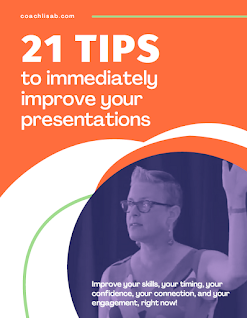Presentation strategies for women -- but not men?
This article has been selected for DeFinis Communications' “Top Presentation Strategies for Women” Blog Carnival. See the rest of the contributors here.
For this blog carnival, I agreed to write about the topic, "Presentation Strategies for Women." So let me ask you this: How many articles have you read titled, "Presentation Strategies for Men?" Yep, that's what I thought. Why do we single out women as needing special advice? This bothers me, and not just in regard to public speaking.
In Western culture, men have long been considered the "norm," and women, by virtue of not being men, have been considered "abnormal" or "deficient." I won't go into the social psychology behind measuring women against men, but I do recommend Carol Tavris' book, The Mismeasure of Women: Why Women Are Not the Better Sex, the Inferior Sex, or the Opposite Sex, a book that explores this in depth. Tavris says,
"The perception of female otherness occurs in every field, as we are learning from critical observers in science, law, medicine, history, economics, social science, literature and art. In medicine, students learn anatomy and physiology and separately, female anatomy and physiology; the male body is anatomy-itself. In art, we have works of general excellence and, separately, works by women artists, generally regarded as different and lesser; male painters represent art-itself. In literature, a college course on "black female writers of the twentieth century" is considered a specialized seminar; yet when an English instructor at Georgetown University called her course "white male writers," it was news, because the works of white male writers are regarded as literature-itself. In psychoanalysis, Freud took the male as the developmental norm for humanity, regarding female development as a pale and puny deviation from it."
Women are supposedly too emotional, not confident, too reticent; we don't have a commanding presence and can't be taken seriously in leadership roles, among other things, all apparently the opposite of what men do, the opposite of what's normal, good and desirable.
By continuing to write about these alleged weaknesses of women presenters, we perpetuate negative perceptions and assumptions about women as speakers and leaders. We perpetuate the myth that women (because of either birth or gender socialization -- we'll never know) need to be fixed.
I work with individuals, and they all have unique characteristics, personalities, flaws, strengths, and needs. I couldn't possibly categorize or stereotype them and give blanket advice.
Whether you're a man or a woman, the same basic principles apply to presenting, so allow me to share some of my favorite tips for a successful presentation, and you can tell me if you think these are more valid for women or men.
1. Learn about your audience and venue in advance.
This allows you to adjust your presentation to the space and to the audience's needs, and to bring appropriate equipment and handouts.
2. Prepare a strong opening and closing.
Grab their attention with a powerful story or inviting question, and close with a call to action – what do you want them to do as a result of your presentation?
3. Engage the audience; ask open-ended questions and invite their participation and knowledge.
It helps the audience learn, and also shows you respect and value them.
4. Lose the jargon.
Jargon is boring and overused, and can create a barrier between you and the audience when they don’t understand, or when you seem to be trying to appear smarter than them.
5. Don’t stress about fillers.
"Um" and "uh" are natural parts of conversation and are only problems in presentations when overused to the point of distraction -- usually because you're unprepared.
6. If you're using equipment (like a projector or microphone), always check it first to make sure it’s working properly.
7. Show your true, authentic self.
Forget about trying to impress people, playing it safe and worrying about what people think of you. Allow your unique personality and style to shine through. This allows the audience to relate to you as a person.
8. Demonstrate enthusiasm for your topic.
Enthusiasm is contagious; if you’re not excited about the topic, how can you expect the audience to be?
9. Make it about the audience.
"What's in it for them?" should be your main focus – put the needs of the audience above your own concerns and insecurities.
10. Keep practicing and taking (and making) as many speaking opportunities as you can; it's the best way to improve your skills.
I'd like to stop trying to figure out how to fix women, and instead look at what all speakers can do to give better presentations. Confidence, engagement, authenticity, connection, presence: Men and women alike want to achieve these goals, and neither gender can claim dominance in any one area when it comes to satisfying an audience.
____________________________________________________
On The Everything Page you'll find everything you need to build visibility, credibility and influence through engaging presentations that move your participants into action: freebies, low-cost products and courses, and 1:1 coaching!




0 comments. Please add yours! :
Post a Comment